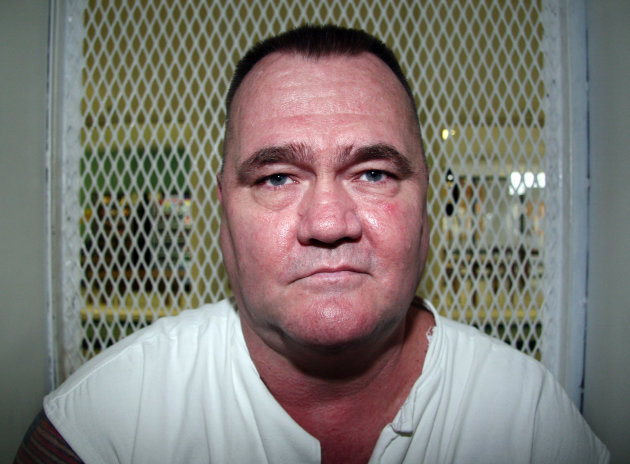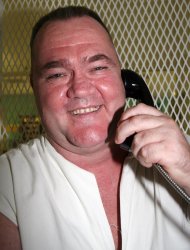By Michael Graczyk

What Cleve Foster remembers most about his recent brushes with death is the steel door, the last one condemned Texas inmates typically walk through before their execution. "You can't take your eyes off that door," he says.
But
twice over the past year and a half, Foster has come within moments of
being escorted through the door, only to be told the U.S. Supreme Court
had halted his scheduled punishment.
On
Tuesday, Foster, 48, is scheduled for yet another trip to the death
house for participating in the abduction and slaying of a 30-year-old
Sudanese woman, Nyaneur Pal
, a decade ago near Fort Worth.
 It takes just under an hour to drive west from the Texas Department of Criminal Justice Polunsky Unit
It takes just under an hour to drive west from the Texas Department of Criminal Justice Polunsky Unit
Foster,
a former Army recruiter known to his death row colleagues as "Sarge,"
denies his role in the murder. Prosecutors say DNA ties him to the
killing and that he gave contradictory stories when questioned about
Pal's death.
"I did not do it," he insisted recently from a tiny visiting cage outside death row
.
Appeals
again were pending in the courts, focusing on what his lawyers argued
was poor legal help both at his 2004 trial in Fort Worth and by
attorneys early in the appeals process. Similar appeals resulted in the
three previous reprieves the courts subsequently have lifted, but his
lawyers argue his case should get another look because the legal
landscape has changed in death penalty cases.
"I don't want to sound vain, but I have confidence in my attorney and confidence in my God," he said. "I can win either way."Pal's relatives haven't spoken publicly about their experiences of going to the prison to watch Foster die, only to be told the punishment has been delayed. An uncle previously on the witness list didn't return a phone call Friday from The Associated Press.
Foster, however, shared his thoughts of going through the mechanics of facing execution in Texas — and living to talk about it.
The
process shifts into high gear at noon on the scheduled execution day
when a four-hour-long visit with friends or relatives ends at the
Polunsky Unit outside Livingston."That last visit, that's the only thing that bothers me," he said. "The 12 o'clock-hour hits. A dozen or so guards come to escort you."
By Foster's count, it's 111 steps to the prison gate and an area known as the box cage. That's where he's secured to a chair for electronic scrutiny to detect whether he has any metal objects hidden on his body.
It's the legacy of inmate Ponchai Wilkerson. Wilkerson, asked by the warden if he had a final statement after he was strapped to the death chamber gurney for execution in 2000, defiantly spit out a handcuff key he'd concealed in his mouth.
"You're in handcuffs, you're chained at the ankles, they give you cloth shoes and you have to shuffle to keep them on," he said.
As he waddles the 111 steps, he gets acknowledgement from fellow prisoners who tap on the glass of their cells.
At
the prison gate, armed officers stand by as he's put in a van and
secured to a seat for the roughly 45-mile trip to Huntsville that he
says feels like a "90-mph drive." There are no side windows in the back
of the van where Foster, accompanied by four officers, rides to the
oldest prison in Texas. Only the back doors have windows.
"It's
like stepping back in time, dungeons and dragons," he said of entering
through two gates at the back of the Huntsville Unit, more commonly
known as the Walls Unit because of its 20-foot-high red brick walls.Prison officials then hustle him into the cell area adjacent to the death chamber.
"Going inside, it's a little spooky. You can tell it's been there a while," he said. "Everything's polished, but still it's real old. You look down the row. History just screams at you.
"It's
almost like 'Hotel California,'" he said, referring to the song by The
Eagles. "You can check out anytime, but you can't leave."
Both
times he's been there, most recently last September, he's been treated
"like a human being," Foster said. Officers look at him but don't smile,
he said.
At one point, he saw someone walk by with a bulging envelope that he assumed contained the lethal injection drugs.
At
4 p.m., during his first trip to the death house in January 2011, he
was served a final meal. He'd asked for several items, including
chicken.
"It tasted so good," he said. "It actually had seasoning on it."
Two
hours later, at the start of a six-hour window when his execution could
be carried out, he received the Supreme Court reprieve.
Since
then, inmates no longer get to make a final meal request. Procedures
were changed after a state lawmaker complained that condemned inmates
were taking advantage of the opportunity and that murder victims never
get that chance.
Foster was
looking forward to nachos and chicken, the same food served to other
inmates the day last year that he made his second trip to the death
house, but he never received it. Instead, his attorney tearfully brought
him news of another Supreme Court reprieve just before dinner time.
He asked for a doggie bag but was refused. He was put back in the van and returned to death row.
"I've
already told the chaplain: Take the phone off the hook before 4
o'clock," he said, anticipating his next trip Tuesday. "I want to get
that last meal."

No comments:
Post a Comment